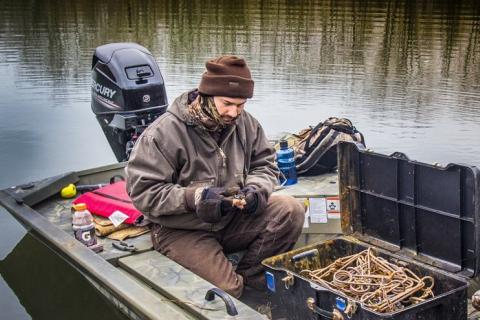
While it seems like dressing in layers for cold weather is a simple process, each year people ask the same questions. Do I really lose more heat from my head? How exactly does wind chill affect me? We answered six of the most common questions about base layers to make sure that you aren't left out in the cold this winter.
1) Which Layer of Clothing is Most Important in Cold Weather?
While selecting the right fabrics and designs for each layer is important, the clothing next to your skin – called the base layer – is most important. It can be considered the quarterback of your layering team. Its performance makes it possible for all of the other layers to do their jobs. Without the right base layer, the system cannot function as a team, and you cannot win against the cold. The most important function of a base layer is to quickly move the liquid that comes from the sweat glands and release it to the air or the next layer of fabric. The ability of a material to grab, move, and release liquid is known as “wicking.”
Tip: Shop men's base layers at Bass Pro Shops here.
Tip: Shop base layers for women at Bass Pro Shops here.

2) Which is More Important, Waterproof or Breathable Clothing?
The key to comfort outdoors in cold or even cool weather is staying dry especially in the layers closest to your skin. When you get wet and stay wet is when you’ll become uncomfortably cold and things can get downright dangerous. Breathable fabrics with strong wicking capabilities are essential to mitigating the moisture your body produces. Waterproof fabrics are the only way to prevent external moisture – rain, snow, humidity, mist, etc. – from entering and compromising your comfort from the outside. So both waterproof and breathable are essential characteristics.
Thankfully, there are a number of technologies to make outer layer – or “shell” --garments that are both waterproof and breathable. The best known of these is Gore-Tex®. Basically it’s a membrane with pores so small that moisture as vapor can penetrate, but moisture as drops of liquid cannot. The whole point of layering clothing for outdoor activity is that you can adjust what you need when you need it. When you’re less active you add layers. When you’re more active you remove layers. When it’s raining, you put on a waterproof shell.
3) Should You Layer Clothing on Your Extremities (i.e. hands and feet?)
Layering your hands for outdoor activity the same way you do your upper body makes a lot of sense. A thin pair of liner gloves under a thicker set of insulating gloves with the option of adding windproof/waterproof mittens over the top will have you covered no matter what you’re doing.

Cabela's Guidewear Glomitts are great when you need warmth and the finger dexterity of gloves. Cabela's gloves feature half-finger construction that lets you flip open the fold-over hood and thumb to expose your fingertips for improved dexterity. Just flip the hood closed again for full-mitt warmth. GORE® WINDSTOPPER® windproof/breathable membranes foil wind while letting your skin breathe.
Tip: Shop men's gloves at Bass Pro Shops here
Tip: Shop women's gloves at Bass Pro Shops here
Feet are a bit different in that you will always wear some kind of insulated boot as an outer layer, however, there are many choices in the amount of insulation built into the boots – from none to tons! Layering of socks can significantly alter the find of your boots which can cause blisters, abrasions, and pain. However, it’s often a good idea to wear a thin pair of liner socks under a thicker pair of wool socks inside of heavily insulated boots for extremely cold conditions in which you’ll be relatively inactive – such as ice fishing or sitting on a late-season deer stand.

If you’ll be more active and only wear one pair of socks, the choice should contain a high percentage of Merino wool. And the best recommendation is to take along and put on a fresh, dry pair of socks at mid-day. You won’t believe how good that feels in cold … or warm … weather. Your feet will thank you!
 4) Is it True You Lose the Most Heat Through Your Head?
4) Is it True You Lose the Most Heat Through Your Head?
 Yes … and no. Yes, if you don’t wear a hat, cap, beanie, hood, or balaclava you can lose a significant amount of body heat through your scalp. However, it’s no more than any other part of your body in which blood vessels are close to the surface of the skin and you’ve left uncovered.
Yes … and no. Yes, if you don’t wear a hat, cap, beanie, hood, or balaclava you can lose a significant amount of body heat through your scalp. However, it’s no more than any other part of your body in which blood vessels are close to the surface of the skin and you’ve left uncovered.

Your bare head (or any bare area of skin, for that matter) will lose heat in two ways: radiation and convection. Radiation is the direct movement of heat as energy to a colder environment around the source of the heat – your scalp radiates heat to the colder air around it. Convection is the transfer of heat by the movement of air or liquids. This is what we know as cooling by wind chill, cold air moving next to your skin, grabbing the heat, and taking it away.
Bottom line is you will lose less heat if you wear something on your head. Layering on you head usually isn’t practical, but having a spare stocking cap in your daypack to put on instead of your ball cap during periods of inactivity will make a big difference. So will wearing a stocking cap at night in your sleeping bag in a cold tent.
5) Do You Really Get Colder From “Wind Chill?”
First of all, it’s impossible for anything – a rock at the North Pole or your skin on a deer stand – to become colder than the actual air temperature around it. Wind chill is actually a measure of how fast convection will bring the temperature of that rock or your skin down to the surrounding air temperature. The stronger the wind, the more rapidly heat is lost by convection. If the actual air temp is 20°F, but there’s a 10 mph wind, the rock or your skin loses heat as if the air temp were actually 9°F with no wind. Yet it would be physically impossible for the actual temperature of the rock or your skin to drop below 20°F.
The key to staying warm in the wind is to prevent the moving cold air from contacting your skin. There are a couple of good ways to do this. First, wear at least one layer of a material that’s windproof. It still needs to be breathable, but needs to prevent moving air from penetrating from the outside. Second, select good insulating materials with loft to wear underneath the windproof layer. “Loft” is basically the pockets of still air trapped in materials like down or fleece. Your body heat warms these pockets and because they don’t move … much … they help your skin stay warm.
6) What is The Best Material for Base Layer Clothing?
Skin is the human body’s largest organ. On average it includes 2.5-3 million sweat glands. Under normal conditions, the average person sweat somewhere around 1 – 1.5 gallons per day without much exertion. Start hiking, climbing, or running and the amounts can go up significantly from there. The synthetic material that does this best is polyester, but it comes with drawbacks of which the biggest is odor retention. The best natural fiber for base layers is Merino wool. It does a great job of wicking and naturally combats odor because of the lanolin retained in the fibers. Merino garments tend to be more expensive, but are well worth the money.
- 23850 views



